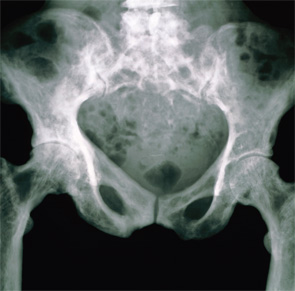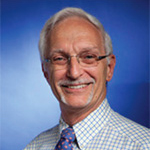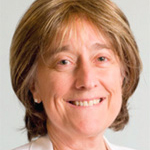
X-ray showing the pelvis of a person with Paget’s disease or osteitis deformans. The pelvic bones have a mottled appearance due to their increased porosity.
Image Credit: SPL /Science Source
CHICAGO—A 49-year-old woman has had RA for eight years. She has a rheumatoid factor reading of 35, an aCCP reading of 160, erythrocyte sedimentation rate of 42, plus erosions. She has been on methotrexate. She tried etanercept for six months, but then it stopped working. She was on 40 mg of adalimumab weekly, but it gave her a rash. Golimumab was ineffective; abatacept didn’t seem to work; rituximab gave her sinusitis twice; and tocilizumab seemed to be effective, but caused her liver function test readings to rise.
“Nothing seemed to work,” said Daniel Furst, MD, director of the Rheumatology Clinical Research Center at the University of California Los Angeles, who presented the case at the American College of Rheumatology’s 2015 State-of-the-Art Clinical Symposium in May, in a talk designed to get clinicians to think “outside the box.”
In other talks in an a la carte session, speakers covered the latest on Paget’s disease of bone and how to make decisions on imaging.
Combination Therapy
For the patient for whom nothing seems to work, Dr. Furst suggested an approach: a concept he calls “the principle of non-overlap.” It’s based on the idea that combination therapies that don’t overlap in mechanism of action and toxicity stand a better chance of being effective.
“This isn’t infallible, but it’s a reasonable way to approach it,” he said. Plus, when it comes to toxicities not overlapping, “if you’re going to get a side effect, at least you’ll know which drug it’s due to.”
Methotrexate and cyclosporine, for example, overlap on their IL-2 effect, but not much else, and data show that they work well together.
For patients like his difficult-to-treat 49-year-old patient, he suggested restarting abatacept, and using cyclosporine because it has a different mechanism of action. If that’s not helpful enough, add tofacitinib.
In another case, a woman kept getting UTIs and wanted a therapy without infections. The research, Dr. Furst said, shows that etanercept has the lowest infection rates among TNF inhibitors, but that non-TNF inhibitors should be considered as well.
He used another case to draw attention to the importance of screening for hepatitis B and C: A 28-year-old man returned from Taiwan. He has had RA for three years, with a slightly elevated RF level and no erosions, but he has an ESR of 60, is fatigued and has tender hands and a few swollen joints.

Dr. Furst
Dr. Furst said it would be wise to look for a cause of the fatigue, ESR level, tenderness and swelling other than RA—in this case, hepatitis B.
With the number of Asian Americans expected to reach 8% of the U.S. population by 2050—and that population has a higher prevalence of hepatitis B infections and downstream hepatocellular carcinoma—the resulting higher prevalence of hepatitis B in the U.S. population “is going to be a problem,” Dr. Furst said.
Studies have shown that TNF inhibitors can sometimes reactivate hepatitis B, making it a relatively inappropriate treatment choice for patients with a history of hepatitis B.1 In a study of rituximab, lymphoma patients receiving CHOP chemotherapy plus rituximab had reactivation of hepatitis B, while those receiving only CHOP did not, making rituximab a poor choice, as well.2
A small study in which Dr. Furst was involved showed that abatacept is feasible in patients with RA and chronic hepatitis B, if background therapy is used.3 He is hoping to examine this in an expanded, well-controlled study.
“For [RA patients with] hepatitis B, from my point of view, always use background therapy,” he said. “I wouldn’t use TNFi’s, but you can if you need to. Abatacept may be the best we’ve got for the moment.”
Paget’s Disease of Bone
Margaret Seton, MD, assistant professor of medicine at Brigham and Women’s Hospital and a leading expert on Paget’s disease of bone, said the disease can be debilitating, but is treatable. She worries that some physicians might not be very familiar with it because fewer cases are being seen.
The disease, first described in 1876, starts in middle age or later and involves bone enlargement and softening, with those bones that are weight-bearing becoming unnaturally curved. Complications include pain, nerve compression, fractures, metabolic disturbances, worsened quality of life and, rarely, osteogenic sarcoma.
One misconception about the disease is that it can spread. It does not, she said. When patients are first diagnosed, Dr. Seton said, it’s important to get a bone scan to define the extent of disease. “It’s very useful as you follow patients over time,” she said.
Elevated levels of alkaline phosphatase (ALP) was once considered a reliable marker of the disease, but it no longer is. A Dutch study of a general population cohort in 2004 found that 86% of those with active Paget’s actually had normal serum ALP.
Dr. Seton described this treatment regimen for an 86-year-old patient with extensive Paget’s disease of bone: 30 mg daily of risedronate given in February and March of 2006, which was minimally effective. Possible reasons for this include poor absorption of the oral drug, inadequate length of treatment or dose.
This treatment regimen was followed by a course of IV pamidronate, which did reduce bone turnover markers by 50%. Over the ensuing months, though, the levels of biomarkers quickly rose again. Pamidronate resistance has been reported with repeated cycles. When the patient’s urine N-terminal telopeptide and serum alkaline phosphatase continued to rise to levels matching those at presentation, the patient was treated with 4 mg of zoledronic acid by infusion, which normalized bone turnover markers.

Dr. Seton
Zoledronic acid, Dr. Seton said, “is very effective therapy for Paget’s disease. It’s even very effective in patients who have failed other bisphosphonates.”
Although studies have shown that zoledronic acid—now approved for Paget’s disease at a 5 mg dose—can result in a sustained biochemical remission of 6.5 years or longer, long-term outcomes may not differ in patients who have been treated aggressively to normalize the serum alkaline phosphatase compared with those patients treated symptomatically.4 This may be due to the nature of the patients treated and captured in this study, for example, those with long-term disease and coexisting morbidities, she said.
“My own interpretation is that they’ve remodeled bone to such an extent that maybe it’s too much to ask of a drug, at the age of 80, to change that [outcome].”
Imaging
With so many ways to image patients now available, the choices of which to use have become more complicated, said Imran Omar, MD, chief of musculoskeletal radiology at the Northwestern University Feinberg School of Medicine, Chicago. Each modality has strengths and drawbacks that can help guide their use, he said.
Clinicians should always start with radiographs because, with well-established patterns of disease, X-rays can give an accurate diagnosis in a lot of patients. They are also highly reproducible and inexpensive.
On the other hand, X-rays are fairly insensitive to bony erosions, soft tissues cannot be seen very well, and they expose patients to radiation, Dr. Omar said.
MRI, with excellent spatial and contrast resolution and clear depictions of anatomy, is frequently used to assess active disease and the extent of disease. But they’re expensive and uncomfortable for some patients.
CT imaging often results in findings similar to X-rays, but soft tissue can be seen more clearly and cross-sectional images can be used to localize findings more accurately.
At his center, CT is often used as a problem-solving tool, Dr. Omar said. “If there is a question on radiography or another imaging study, such as MRI, we often will go to CT,” he said.
Ultrasound, which is coming into wider use, is helpful in assessing effusions, synovial proliferation and tendon pathology—and even obese or claustrophobic patients usually have little trouble getting an ultrasound, he said. Plus, the field of view is flexible and they can cost as little as one-fourth of what an MRI costs. But ultrasounds are very dependent on the expertise of the operator, he cautioned.
As for nuclear medicine, bone scintigraphy is very sensitive in picking up bone turnover but cannot answer why it’s happening, Dr. Omar said. PET imaging can be helpful in finding the site of active disease or in monitoring therapy, but is relatively costly, he said.
His center doesn’t put nuclear medicine to wide use, he said.
“A lot of our other modalities can provide a lot of the same information,” Dr. Omar said. “So we rarely use nuclear medicine specifically to look for a lot of these diseases.”
Thomas R. Collins is a freelance medical writer based in Florida.
References
- Urata Y, Uesato R, Tanaka D, et al. Prevalence of reactivation of hepatitis B virus replication in rheumatoid arthritis patients. Mod Rheumatol. 2011 Feb;21(1):16–23.
- Yeo W, Chan TC, Leung NW, et al. Hepatitis B virus reactivation in lymphoma patients with prior resolved hepatitis B undergoing anticancer therapy with or without rituximab. J Clin Oncol. 2009 Feb 1;27(4):605–611.
- Kim PS, Ho GY, Prete PE, et al. Safety and efficacy of abatacept in eight rheumatoid arthritis patients with chronic hepatitis B. Arthritis Care Res (Hoboken). 2012 Aug;64(8):1265–1268.
- Langston AL, Campbell MK, Fraser WD, et al. Randomized trial of intensive bisphosphonate treatment versus symptomatic management in Paget’s disease of bone. J Bone Miner Res. 2010 Jan;25(1):20–31.
